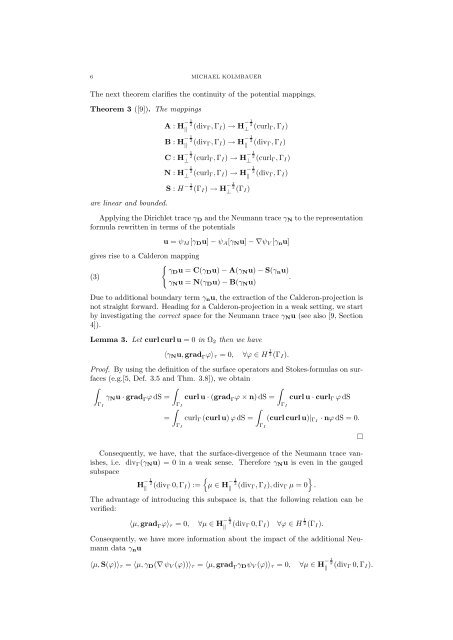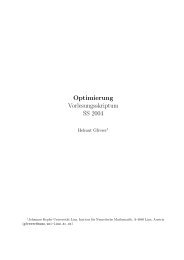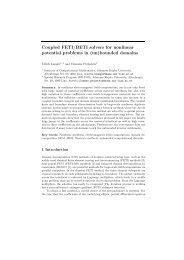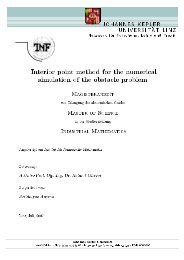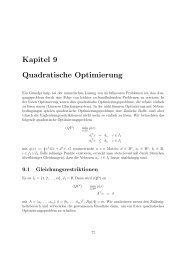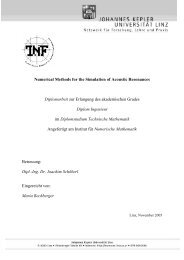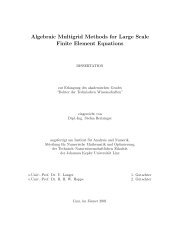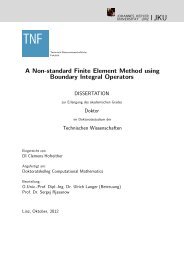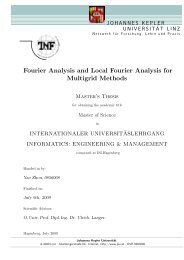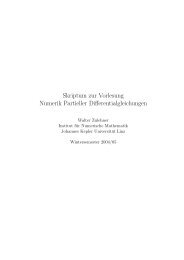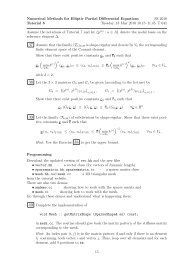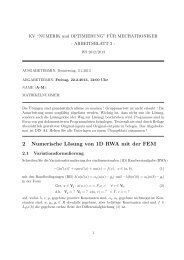Existence and Uniqueness of Eddy Current Problems in Bounded ...
Existence and Uniqueness of Eddy Current Problems in Bounded ...
Existence and Uniqueness of Eddy Current Problems in Bounded ...
You also want an ePaper? Increase the reach of your titles
YUMPU automatically turns print PDFs into web optimized ePapers that Google loves.
6 MICHAEL KOLMBAUER<br />
The next theorem clarifies the cont<strong>in</strong>uity <strong>of</strong> the potential mapp<strong>in</strong>gs.<br />
Theorem 3 ([9]). The mapp<strong>in</strong>gs<br />
are l<strong>in</strong>ear <strong>and</strong> bounded.<br />
A : H − 1 2<br />
‖<br />
(div Γ , Γ I ) → H − 1 2<br />
⊥ (curl Γ, Γ I )<br />
B : H − 1 2<br />
‖<br />
(div Γ , Γ I ) → H − 1 2<br />
‖<br />
(div Γ , Γ I )<br />
C : H − 1 2<br />
⊥ (curl Γ, Γ I ) → H − 1 2<br />
⊥ (curl Γ, Γ I )<br />
N : H − 1 2<br />
⊥ (curl Γ, Γ I ) → H − 1 2<br />
‖<br />
(div Γ , Γ I )<br />
S : H − 1 2 (ΓI ) → H − 1 2<br />
⊥ (Γ I)<br />
Apply<strong>in</strong>g the Dirichlet trace γ D <strong>and</strong> the Neumann trace γ N to the representation<br />
formula rewritten <strong>in</strong> terms <strong>of</strong> the potentials<br />
gives rise to a Calderon mapp<strong>in</strong>g<br />
u = ψ M [γ D u] − ψ A [γ N u] − ∇ψ V [γ n u]<br />
(3)<br />
{<br />
γD u = C(γ D u) − A(γ N u) − S(γ n u)<br />
.<br />
γ N u = N(γ D u) − B(γ N u)<br />
Due to additional boundary term γ n u, the extraction <strong>of</strong> the Calderon-projection is<br />
not straight forward. Head<strong>in</strong>g for a Calderon-projection <strong>in</strong> a weak sett<strong>in</strong>g, we start<br />
by <strong>in</strong>vestigat<strong>in</strong>g the correct space for the Neumann trace γ N u (see also [9, Section<br />
4]).<br />
Lemma 3. Let curl curl u = 0 <strong>in</strong> Ω 2 then we have<br />
〈γ N u, grad Γ ϕ〉 τ = 0, ∀ϕ ∈ H 1 2 (ΓI ).<br />
Pro<strong>of</strong>. By us<strong>in</strong>g the def<strong>in</strong>ition <strong>of</strong> the surface operators <strong>and</strong> Stokes-formulas on surfaces<br />
(e.g.[5, Def. 3.5 <strong>and</strong> Thm. 3.8]), we obta<strong>in</strong><br />
∫<br />
∫<br />
∫<br />
γ N u · grad Γ ϕ dS = curl u · (grad Γ ϕ × n) dS = curl u · curl Γ ϕ dS<br />
Γ I Γ I Γ<br />
∫<br />
∫<br />
I<br />
= curl Γ (curl u) ϕ dS = (curl curl u)| ΓI · nϕ dS = 0.<br />
Γ I Γ I<br />
Consequently, we have, that the surface-divergence <strong>of</strong> the Neumann trace vanishes,<br />
i.e. div Γ (γ N u) = 0 <strong>in</strong> a weak sense. Therefore γ N u is even <strong>in</strong> the gauged<br />
subspace<br />
{<br />
}<br />
H − 1 2<br />
‖<br />
(div Γ 0, Γ I ) := µ ∈ H − 1 2<br />
‖<br />
(div Γ , Γ I ), div Γ µ = 0 .<br />
The advantage <strong>of</strong> <strong>in</strong>troduc<strong>in</strong>g this subspace is, that the follow<strong>in</strong>g relation can be<br />
verified:<br />
〈µ, grad Γ ϕ〉 τ = 0, ∀µ ∈ H − 1 2<br />
‖<br />
(div Γ 0, Γ I ) ∀ϕ ∈ H 1 2 (ΓI ).<br />
Consequently, we have more <strong>in</strong>formation about the impact <strong>of</strong> the additional Neumann<br />
data γ n u<br />
〈µ, S(ϕ)〉 τ = 〈µ, γ D (∇ ψ V (ϕ))〉 τ = 〈µ, grad Γ γ D ψ V (ϕ)〉 τ = 0, ∀µ ∈ H − 1 2<br />
‖<br />
(div Γ 0, Γ I ).<br />
□


